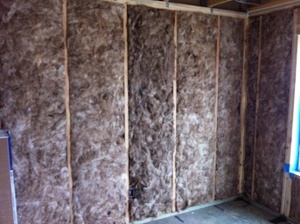Rare Grade I Fiberglass Batt Insulation Sighting

One of the great benefits of going out into the field to do quality assurance and training for HERS raters is that I get to see what’s going on in new construction. Last week I visited HERS raters in Nashville, Memphis, and Birmingham and got to see that there’s some good stuff happening in the world of home building. Yesterday I wrote about a net zero energy house near Memphis. Today, I’m going to just show you a photo of something I’ve seen only three times now – fiberglass batt insulation installed to RESNET Grade I quality.
The photo above shows how fiberglass batt insulation should be installed. Each batt is cut to the correct width and length for the cavity. The installers cut notches out so that the batts fit around electrical junction boxes. They split the batts to go around wires. What you see above is just about perfect.
One thing that I believe makes them easier to install well is that they’re unfaced. There’s no kraft-paper facing on them, so they’re easier to cut and fit properly. The building code now allows unfaced batts for the warmer climate zones, so if you want to go with batts, get the unfaced type if they’re allowed in your climate zone.
If you’re wondering what kind of batts these are, they’re the Ecobatt made by Knauf. Any batt can be installed well, and any batt can be installed poorly. The Ecobatt has some other properties in its favor, though. They’ve reduced the petroleum that goes into the making of this material and kept some of the other nasties out as well.
petroleum that goes into the making of this material and kept some of the other nasties out as well.
This particular installation is a Habitat for Humanity community in Nashville, in which the homes will have the ENERGY STAR label and be certified in the LEED for Homes program. They’ve got it going on up there, and these Grade I fiberglass batts prove that you can build affordably and still do it right.
This Post Has 8 Comments
Comments are closed.

Very nice and indeed, Ver
Very nice and indeed, Ver rare!
It does look like a good
It does look like a good initial install. I wonder if there will be any settling without a kraft paper holding the fiberglass up? Of course, you could over-stuff the cavity to help prevent settling, but then the cost would escalate and the R-value would stay about the same.
I’ve been seeing some pretty
I’ve been seeing some pretty good Batts installs in the Asheville area lately too. Challenging the batts-are-bad idea. It has mostly been unfaced batts too, so you might be on to something.
We have qualified over 10,000
We have qualified over 10,000 homes to the Energy Star New Homes program with the vast majority of those homes being G1 FG jobs. Not as uncommon as you would think.
This is great to see. I&
This is great to see. I’ve worked with Habitat for Humanity Dekalb (GA), and know of other affiliates who are building to Energy Star or other green standards to take advantage of new grants. If they can do this while leading inexperienced volunteers in the installation, there’s no reason “professional” installers can’t produce similar quality work.
Dave,
Dave,
The builder I worked for had the same question about unfaced batts settling over time when it was suggested by the HERS raters of our green program. These are cut slightly wider than the cavity and should be cut slightly longer than the stud length to provide a friction fit and prevent settling. In my experience, this works well.
We do all the work on the
We do all the work on the Habitat houses in the Chattanooga area. We always use Knauf fiberglass batts and the standard is grade one installation…inspected.
The methods described here
The methods described here are standard insulation work in B.C.
I haven’t seen any paper-backed insulation for decades.
Fibreglass insulation will become compact and sag if it gets damp, and it also loses some insulation value because of condensation during the winter. Moist fibreglass with dust on it can also be a growth medium for mold.
I have seen black mold growing on insulation in fairly new houses that weren’t properly done. So proper istallation and air-sealing of poly and is very necessary.
As is making sure there are no holes in the poly.
Air-tight shields around electrical boxes are also important, and they should be taped to the poly when installed.
Personally, I prefer rockwool insulation, which is stiffer and has a higher R-value (R-22.5 for the 2×6 cavity.) It can get soaked and still won’t sag in the cavity. Also, mold won’t grow on it. It is a denser material, so it fits more snugly in the cavity and won’t settle over time.